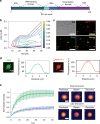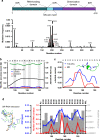Nucleocapsid protein of SARS-CoV-2 phase separates into RNA-rich polymerase-containing condensates
- PMID: 33247108
- PMCID: PMC7699647
- DOI: 10.1038/s41467-020-19843-1
Nucleocapsid protein of SARS-CoV-2 phase separates into RNA-rich polymerase-containing condensates
Abstract
The etiologic agent of the Covid-19 pandemic is the severe acute respiratory syndrome coronavirus 2 (SARS-CoV-2). The viral membrane of SARS-CoV-2 surrounds a helical nucleocapsid in which the viral genome is encapsulated by the nucleocapsid protein. The nucleocapsid protein of SARS-CoV-2 is produced at high levels within infected cells, enhances the efficiency of viral RNA transcription, and is essential for viral replication. Here, we show that RNA induces cooperative liquid-liquid phase separation of the SARS-CoV-2 nucleocapsid protein. In agreement with its ability to phase separate in vitro, we show that the protein associates in cells with stress granules, cytoplasmic RNA/protein granules that form through liquid-liquid phase separation and are modulated by viruses to maximize replication efficiency. Liquid-liquid phase separation generates high-density protein/RNA condensates that recruit the RNA-dependent RNA polymerase complex of SARS-CoV-2 providing a mechanism for efficient transcription of viral RNA. Inhibition of RNA-induced phase separation of the nucleocapsid protein by small molecules or biologics thus can interfere with a key step in the SARS-CoV-2 replication cycle.
Conflict of interest statement
The authors declare no competing interests.
Figures





Similar articles
-
Targeting the liquid-liquid phase separation of nucleocapsid broadly inhibits the replication of SARS-CoV-2 strains.Biochem Biophys Res Commun. 2025 Apr 5;756:151594. doi: 10.1016/j.bbrc.2025.151594. Epub 2025 Mar 6. Biochem Biophys Res Commun. 2025. PMID: 40086356
-
Genomic RNA Elements Drive Phase Separation of the SARS-CoV-2 Nucleocapsid.Mol Cell. 2020 Dec 17;80(6):1078-1091.e6. doi: 10.1016/j.molcel.2020.11.041. Epub 2020 Nov 27. Mol Cell. 2020. PMID: 33290746 Free PMC article.
-
SARS-CoV-2 nucleocapsid protein forms condensates with viral genomic RNA.PLoS Biol. 2021 Oct 11;19(10):e3001425. doi: 10.1371/journal.pbio.3001425. eCollection 2021 Oct. PLoS Biol. 2021. PMID: 34634033 Free PMC article.
-
The nucleocapsid protein of zoonotic betacoronaviruses is an attractive target for antiviral drug discovery.Life Sci. 2021 Oct 1;282:118754. doi: 10.1016/j.lfs.2020.118754. Epub 2020 Nov 12. Life Sci. 2021. PMID: 33189817 Free PMC article. Review.
-
Intrinsic Factors Behind Long COVID: VI. Combined Impact of G3BPs and SARS-CoV-2 Nucleocapsid Protein on the Viral Persistence and Long COVID.J Cell Biochem. 2025 May;126(5):e70038. doi: 10.1002/jcb.70038. J Cell Biochem. 2025. PMID: 40415285 Review.
Cited by
-
A novel cell culture system modeling the SARS-CoV-2 life cycle.PLoS Pathog. 2021 Mar 12;17(3):e1009439. doi: 10.1371/journal.ppat.1009439. eCollection 2021 Mar. PLoS Pathog. 2021. PMID: 33711082 Free PMC article.
-
Discovery and structural characterization of chicoric acid as a SARS-CoV-2 nucleocapsid protein ligand and RNA binding disruptor.Sci Rep. 2022 Nov 2;12(1):18500. doi: 10.1038/s41598-022-22576-4. Sci Rep. 2022. PMID: 36323732 Free PMC article.
-
Energetic and structural features of SARS-CoV-2 N-protein co-assemblies with nucleic acids.iScience. 2021 Jun 25;24(6):102523. doi: 10.1016/j.isci.2021.102523. Epub 2021 May 7. iScience. 2021. PMID: 33997662 Free PMC article.
-
Structural phylogenetic analysis reveals lineage-specific RNA repetitive structural motifs in all coronaviruses and associated variations in SARS-CoV-2.Virus Evol. 2021 Jun 16;7(1):veab021. doi: 10.1093/ve/veab021. eCollection 2021 Jan. Virus Evol. 2021. PMID: 34141447 Free PMC article.
-
An interchangeable prion-like domain is required for Ty1 retrotransposition.bioRxiv [Preprint]. 2023 Feb 27:2023.02.27.530227. doi: 10.1101/2023.02.27.530227. bioRxiv. 2023. Update in: Proc Natl Acad Sci U S A. 2023 Jul 25;120(30):e2303358120. doi: 10.1073/pnas.2303358120. PMID: 36909481 Free PMC article. Updated. Preprint.
References
-
- Virological.org. Novel 2019 Coronavirus Genome. Available online: http://virological.org/t/novel-2019-coronavirus-genome/319. (2020).
Publication types
MeSH terms
Substances
LinkOut - more resources
Full Text Sources
Other Literature Sources
Medical
Molecular Biology Databases
Miscellaneous

